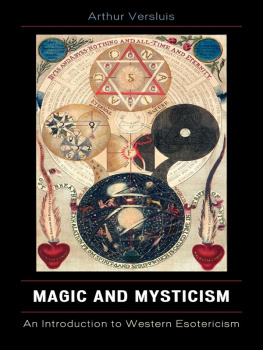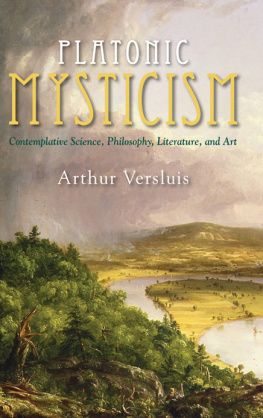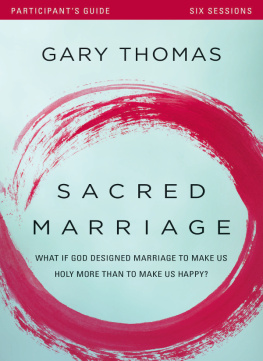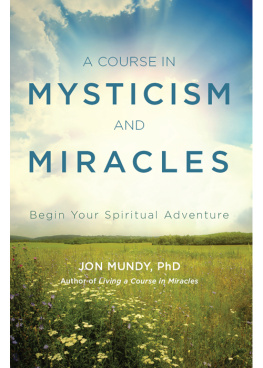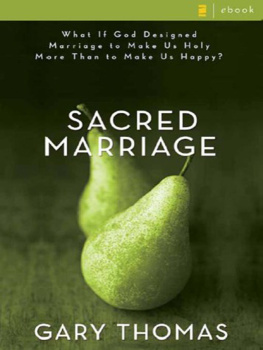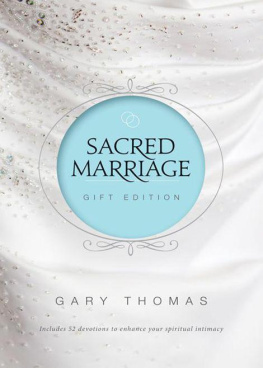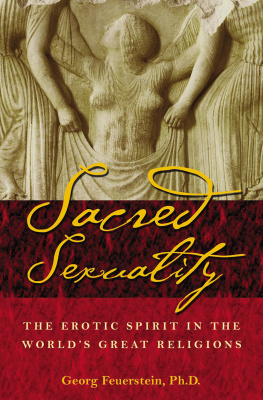Versluis - The secret history of western sexual mysticism : sacred practices and spiritual marriage
Here you can read online Versluis - The secret history of western sexual mysticism : sacred practices and spiritual marriage full text of the book (entire story) in english for free. Download pdf and epub, get meaning, cover and reviews about this ebook. City: Rochester, Vt, year: 2008, publisher: Inner Traditions / Bear & Company;Destiny Books, genre: Religion. Description of the work, (preface) as well as reviews are available. Best literature library LitArk.com created for fans of good reading and offers a wide selection of genres:
Romance novel
Science fiction
Adventure
Detective
Science
History
Home and family
Prose
Art
Politics
Computer
Non-fiction
Religion
Business
Children
Humor
Choose a favorite category and find really read worthwhile books. Enjoy immersion in the world of imagination, feel the emotions of the characters or learn something new for yourself, make an fascinating discovery.

The secret history of western sexual mysticism : sacred practices and spiritual marriage: summary, description and annotation
We offer to read an annotation, description, summary or preface (depends on what the author of the book "The secret history of western sexual mysticism : sacred practices and spiritual marriage" wrote himself). If you haven't found the necessary information about the book — write in the comments, we will try to find it.
Versluis: author's other books
Who wrote The secret history of western sexual mysticism : sacred practices and spiritual marriage? Find out the surname, the name of the author of the book and a list of all author's works by series.
The secret history of western sexual mysticism : sacred practices and spiritual marriage — read online for free the complete book (whole text) full work
Below is the text of the book, divided by pages. System saving the place of the last page read, allows you to conveniently read the book "The secret history of western sexual mysticism : sacred practices and spiritual marriage" online for free, without having to search again every time where you left off. Put a bookmark, and you can go to the page where you finished reading at any time.
Font size:
Interval:
Bookmark:
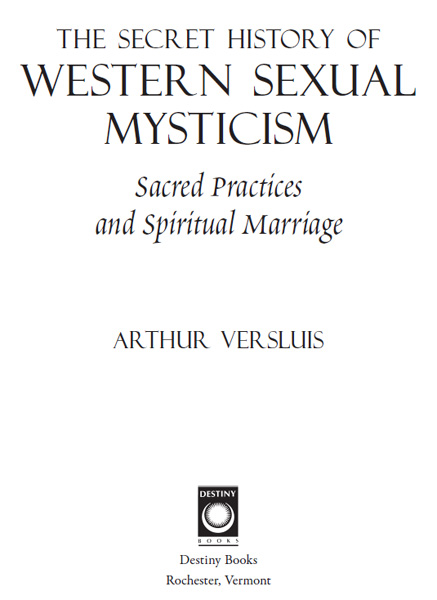
CONTENTS

1
2
3
4
5
6
7

INTRODUCTION
V ery few people know that there are long-standing traditions of sexual mysticism in the West. During the last quarter of the twentieth century, many in the West became aware of Hindu and Buddhist forms of Tantra, but as Hugh Urban and other scholars in that field have shown, tantric traditions were often distorted in the process of transmission or transference to the modern West, where they frequently became commodified and trivialized. This never happened to esoteric Western traditions of sexual mysticism, primarily because they were entirely unknown. This is the first book to outline the existence of such traditions, and in what follows, I will describe for the first time in print the hidden history and nature of Western sexual mysticism.
Of course, we should begin by explaining what we mean by sexual mysticism in the first place. After all, the very term mysticism is ambiguous, for some even synonymous with woolly-headed. The word mystic derives from the Greek word mustein, meaning silent or closed lips, and it has the same origin as the word mystery. The words mysticism and mystery are associated with the ancient Greek Mystery (revelatory and initiatory) traditions of antiquity, which, as we shall see, certainly had sexual dimensions. As far back as we can trace, the word mysticism refers to religious traditions that point us toward inexpressible transcendence of the apparent division between subject and object, or self and other, and toward realization of the divine.
When we look back into Greek and Roman antiquity, we see that the Mystery traditions almost always had sexual dimensions, and there is good reason for this. The Mystery traditions, be they Bacchic, Dionysiac, Eleusinian, or Orphic, were closely bound up with the cosmic cycles, and in particular with the cycles of agricultural and human fertility. In fact, the earlier forms of the Mystery traditions, including during the Hellenistic period, were in the domain of women. Only later were men allowed to be priests in many of the traditions, and the orgia (orgiastic celebrations) took place under the auspices of women. What we are looking at in these ancient traditions bears little relation to the common stereotype of femininity as demure, coquettish, or passive. The women described in some of the ancient Mystery traditions seem to our eyes (as to those of their contemporaries) frenzied, wild, and dangerous, but this authentic wildness expresses a dimension of nature itself that we moderns often fail to recognize.
We will discuss the Greco-Roman Mysteries in much more detail soon, but it is worthwhile here to at least note the profound connection between nature and the Mystery traditions during the entire period of antiquity and late antiquity. The Dionysiac rites and the Bacchanalia took place outdoors, and often at night; and although the rites were associated with the fertility of nature, that was not their only dimension. The Mysteries entailed direct contact with the transcendent forces of the cosmos, which, although they are expressed in the natural world, have their origins in pagan divinity. There is a fierceness in the Mystery traditions, and a dissolution of civilization, that is very important in understanding both their power and their dangers.
When we turn to the advent of Christianity within the declining pagan world, we see something quite different and, in many respects, new. There really is a changing of the age represented by the shift from the ancient Mysteries to the mysteries of Christianity. There were Stoic and other ascetic or semiascetic traditions within Greco-Roman In this, as in many other aspects, even the apparent similarities between the two broad traditions turn out to be differences.
And yet there is a notable kind of continuity in one respect. Although it is almost never discussed except in the works of specialists, early Christianity also entailed a sexual dimension. As we shall see, one should not simply dichotomize between, on the one hand, the orgiastic traditions of Greco-Roman antiquity, and Christian asceticism on the other. Christianity, after all, was not a single movement or sect, but a whole series of phenomena that emerged in the midst of late antiquity and that included a gamut of possibilities, all the way from asceticism to license. And even within what later became known as orthodox Christianity, there was a mysterious tradition of subintroductae, in which men and women lived and slept together, but without male ejaculation. Thus there was a Christian tradition from very early onit is mentioned by Paul himselfof sexual mysticism: that is, of drawing on sexual tension and power, but harnessing it to achieve spiritual transcendence.
There is, of course, much more also to discuss in the Christian traditions of late antiquity. One cannot consider Christianity as a single entity, but rather as a congeries of very different currents of thought and practice, which we see exemplified both in the Apocrypha and in the various Gnostic traditions and compendia. In fact, a fairly reasonable case could be made that pagan orgiastic traditions did not disappear, but were subsumed into various forms of Christianity, sometimes called gnostic. But even here, there was a real distinction from the earlier cosmological traditions of antiquity. Christianity added gnosis, a metaphysical or transcendent dimension, which changed everything. In a very profound sense, Christianity was not of this world, and we see this not only in the New Testament, but also in what remains of the various Gnostic writings.
What we see in the Nag Hammadi library, and in the other fragments of actual Gnostic writings, is the sense that the material world is a realm of suffering and ignorance. This is a profound revision of the earlier, pagan celebration of nature, and it reflects a Gnostic and, more broadly, a Christian sense that Christ represented something new and irrevocable: the appearance in this troubled human world of divine grace and transcendence beyond it. Whether Docetic or not, the Gnostic Christ represents a new and resplendent divine revelation. Whereas in the pagan world, transcendence was to be found in nature, in the new Gnostic world, transcendence was separate from and beyond nature.
The Christian revelation focused, much more than its pagan predecessors, on the human sphere. That Christ appeared in human form is central for Christianity. But also central for Christianity is the beyond, the transcendent, the millennial, and the heavenly. These two tendencies did offer the possibility for incorporating sexual dimensions into the Christian path, and that is what we see during the early Christian period, both in Gnosticism and in what came to be called orthodox Christianity. Many priests and bishops lived with women, and it seemed possible, early on at least, that Christianity might represent not only an ascetic rejection of pagan excesses, but also entirely new roles for men and women, drawing on, incorporating, and transcending sexuality in order to restore humanity to paradisal wholeness.
However, this new model was not to last. Within several hundred years, a historicist and ascetic form of Christianityrepresented in figures like Augustine of Hippobecame dominant, and other kinds of Christianity either disappeared or went underground. During the first few centuries after Christ, Gnostic Christianity offered a pluralist model not dissimilar from what we see in Buddhism. Indeed, there is significant evidence of cross-pollination between Buddhism and Gnosticism, as between Greek and Asian civilizations. One sees this clearly in the development of Buddhist art, which reveals strong Greek influence, and there are real parallels between Buddhism and some Gnostic writings and figures. Gnosticism represents what Christianity could have become, had it taken a path closer to that of Buddhism.
Next pageFont size:
Interval:
Bookmark:
Similar books «The secret history of western sexual mysticism : sacred practices and spiritual marriage»
Look at similar books to The secret history of western sexual mysticism : sacred practices and spiritual marriage. We have selected literature similar in name and meaning in the hope of providing readers with more options to find new, interesting, not yet read works.
Discussion, reviews of the book The secret history of western sexual mysticism : sacred practices and spiritual marriage and just readers' own opinions. Leave your comments, write what you think about the work, its meaning or the main characters. Specify what exactly you liked and what you didn't like, and why you think so.

